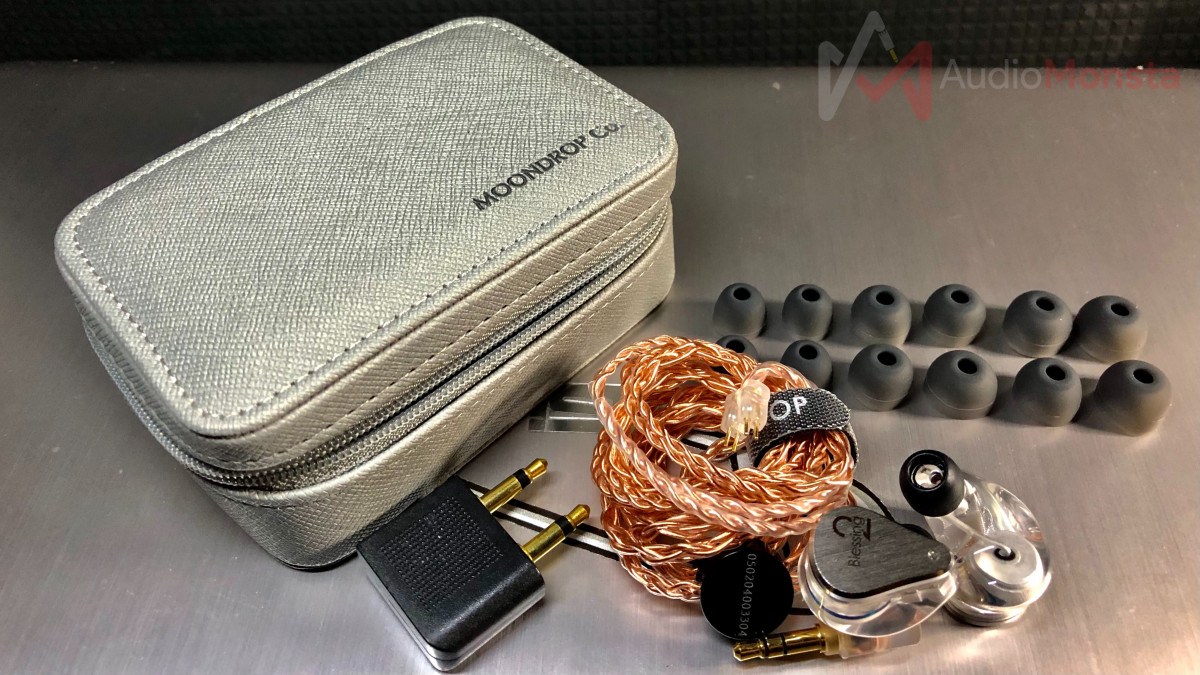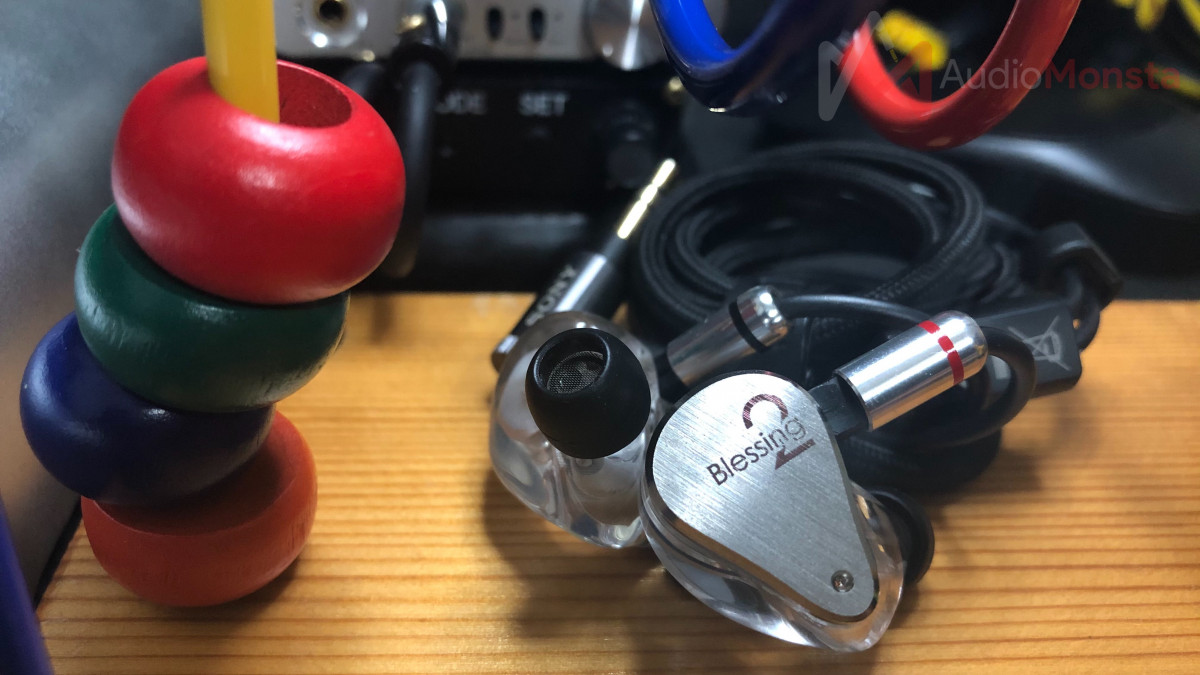Intro
Moondrop Blessing 2. This particular IEM was intended to give a shake to the “reference sounding” monitors that have been dominated by some of the biggest names in the industry. Heck, one of them are the legends who started the in-ear monitor niche with a proven long track record. And challenging such a giant is honestly quite a feat and might be a long shot, unless you know how.
One in particular giant is Etymōtics. They have been in the game for a few decades and their IEM lineups are proven to be some of the most accurate sounding IEMs out there. And as of the year 2020, the Moondrop Blessing 2 is touted to be a benchmark for IEMs within the class. Is this legit or will it be just another fly-by hype train that will be swiftly forgotten as it reaches your storage cases? Let’s see.
Packaging
For the price, there’s nothing much here. It’s simple yet effective. Effective enough to get you to start giving praises to the sonic performance that it offers once you give them a listen. It’s a simple rectangular white box sleeve with a waifu printed on the front including the IEM name. Nothing else. The actual box however, is matte in color with a minimalistic Moondrop logo printed on top of the box. Inside, you’ll find a p-leather carrying case that holds the head unit and another smaller matte box which contains the eartips, airplane adapter and the cable. There’s also some paperwork for those who actually read those.


Functions & Specifications
- Material: 3D printed shell with steel faceplate.
- Transducer Type: 1x Dynamic Driver, 4x Balanced Armature.
- Sensitivity: 117dB/Vrms @ 1kHz
- Impedance: 22ohms @ 1kHz
- Frequency Range: 9Hz – 37kHz
What’s in The Box
- Moondrop Blessing 2
- Silicon eartips (S, M, L) x 2 pairs each
- Airplane adapter
- Carry case

Retail Price & Where To Get
RM1,299.00 @ Red Ape Headphone Store
Sound & Tonality
Neutral, slightly (a touch, not much) warm with upper mids emphasis. These are tuned to bear the “Diffuse Field Neutral” sound signature (Virtual Diffuse Sound Field : VDSF) and works really great for monitoring purposes aside from being somewhat musical for those who prefer the neutral-ish signature. The linearity of the bass might be lacking for some, the mids can be quite revealing and the treble may get hot at times. Tonality is on the natural side of things despite being neutral, lean and are somewhat coherent (typical to most hybrids) sounding which shows the tuning prowess from Moondrop.
Source used:
Xduoo X2S > Xduoo XQ-10 > Moondrop Blessing 2
Win10 > Stoner Acoustics UD130 > IFI micro iDSD Black Label (amp section) > Moondrop Blessing 2
Songs used :
- Ratatat – Bruleé
- 2Cellos – Celloverse
- Dayang Nurfaezah – Lelaki Teragung
- Roxette – It Must Have Been Love
- XPDC – Hentian Ini
- Bon Jovi – Wanted Dead Or Alive
Bass
Sub-bass is present but nowhere near being decent or satisfying for that matter if coming from a fuller sounding IEM, not to mention there’s no physically engaging rumble here. Mid-bass is punchy, energetic and quite textured (although not as detailed as some DD set). Overall the bass is not overly pronounced or giving additional color (character) to the songs. Just being smoothly accurate to say the least. Linear is what I would describe them to be and for those who prefer a punchy, considerably fast attack/decay with top of the line transient response, the Blessing 2 can certainly give you that.
Mids
There’s no audible upper-bass to lower-mids bass bleed due to the applaudable dynamic driver transient response. The mids on the Blessing 2 is lean and clean. The somewhat smooth bass-mids transition apparently gave them just enough body to stay away from being thin sounding. Upper-mids can sometimes be perceived as being shouty, depending on the songs. In fact might be too much for some. But that is among the significant contributors to the Blessing 2 to be transparent sounding. With that, they’re one of the more detailed, revealing IEM out there.
Treble
Lower-treble can suffer a bit of in-your-face presence due to the hot upper-mids. But then the shimmer and sparkles that the Blessing 2 can offer is pretty rewarding. Articulated, precise treble is the word here. Not to mention the extension is above average for the price point. Every minute nuances can be perceived clearly while not being anywhere near sibilance. For those who pursue the tingling sensation (still moderately acceptable by most ears, not too much to be honest) that lingers during your listening session, the Blessing 2 can be one of the best options.
Sounstage
The Blessing 2 for me have a slightly above average, more width than depth with presence of height. It’s some sort of being oval-ish due to the width that it presents. They expand well up to slightly behind your ears and with the presence of height, it does provide you with quite a different (engaging and interesting) listening experience. For some, it may be 3-dimensional, almost there but not quite as holographic sounding.
Imaging & Separation
For gaming, imaging capability is excellent on the Blessing 2. Every spatial cues are precise with one of the best layering capability that I have experienced. This also renders the separation to be very distinct among the different in-game audio cues intended to provide immersive and intense gaming experience. Accompanied with the above average (almost holographic) soundstage, it definitely provides you the edge towards winning the game if you’re playing competitively.
Drivability
Not that it really matters or of any significance, but they do scale with better dacs and power output (as any relatable head-fi gears do). Usage with mobile phone can definitely be enjoyable but with proper gears, they’ll reveal everything to you music nerds.
Synergy
They play really well with warm sources in order to compensate for the lean monitor-ish sound signature. If you have a neutral or bright source, the upper mids can get a bit shouty and the treble brilliance might be too much to fathom and making them fatiguing for long listening sessions.
Comparison
FiiO FD5
For a start, FiiO’s FD5 is a differently tuned IEM which possess a mild V-shape fun sound signature. Not to mention that it is only a single dynamic driver. This might be a non-sensical comparison to begin with. Nonetheless, this comparison acts as an anchor point between a well-received fun sound signature and the reference-inclined neutral-ish sound signature.
The FD5’s bass is much more pronounced especially in the sub-bass region. Mid-bass however is punchier on the Blessing 2 while the FD5 is more textured in comparison. Going up to the mids, both IEMs are clean but much leaner on the Blessing 2. There’s no competition for detail retrieval between the two as Moondrop’s Blessing 2 clearly have an advantage of having balanced armature drivers. But on its own, the FD5 is excellent considering it’s just a single dynamic driver. Treble however is much more pleasant on the FD5. It shimmers and sparkles but nowhere near being as somewhat near edgy on the Blessing 2. Extension on both ends can be considered similar for both IEMs.
On to technicalities, the soundstage on the FD5 is undoubtedly wider, deeper and one can say that it is more holographic in comparison to the Blessing 2. Imaging while being impressively accurate on the FD5, the Blessing 2 seems to deliver accuracy in a more refined manner. Separation is almost on par for both eventhough the FD5 can sometimes struggle with more complex and demanding arrangements. In short, the FD5 is much more “lush”, “grand” and more all-rounder to listen to various genres of music (especially live concert) while the Blessing 2 is more towards dissecting the music to the listener.

Etymōtic ER3SE
When Moondrop announced the Blessing 2, one thing that intrigues me the most was the tuning. It was touted to present a Diffuse Field Neutral signature with a slight bass lift which reminds me none other than the Etymōtics. Unfortunately for me I only have the ER3SE and not the ER4XR (or any of the XR versions) for a direct comparison. Truth be told, the ER3SE is my benchmark for technicalities and it still is one of the most accurate IEM in my stash. Period. But..there’s always a but. But the Blessing 2 really hit the marks where it matters in that regard. Paired with that slight warmth, it renders the Blessing 2 as a pleasantly neutral and somewhat accurate sounding IEM (at least for me).
The Etys sounds anaemic and sterile in comparison (well it’s the SE version anyway). Bass is more prounounced, (especially the sub-bass region) more impactful on the Blessing 2 and have a more natural, less textured presentation in comparison. Mids on the ER3SE while being detailed, the Blessing 2 seems to be a touch more revealing of micro details at the cost of being a bit shoutier in the upper mids in comparison. On to the treble, now this is where the Blessing 2 outshines the ER3SE. The treble extension on the Blessing 2 is much more articulated than that of the ER3SE which gives you all the nuances and shimmery details to drool upon. This renders the ER3SE to be darker sounding in comparison.
While the ER3SE have a more evenly holographic soundstage (albeit smaller), the Blessing 2 is noticeably wider and a bit deeper sounding (thanks to the dynamic driver). Imaging accuracy is on par and almost indistinguishable between the two but separation is noticeably more distinguished on the Blessing 2. Timbre is undoubtedly more natural on the Blessing 2 to say the least. Adding some creaturely comfort to the shell design accompanied with the already excellent sonic performance, there you have it, an IEM that’s very capable for professional work while sounding great for critical listening. Need I say more? The Etymōtic is undeniably excellent for professional use but the Blessing 2 really does give it a run for its money.

Worthy mention
Moondrop SSR
If you already own or have heard the SSR and like what it offers, then look no further. The Blessing 2 is the next direct upgrade. Despite the arguably shouty sound signature on both IEMs, what the Blessing 2 offer is sheer technical performance upgrade. Resolution is much more appealing on the Blessing 2. The slight bass lift gives body to the overall tonality which was missing on the SSR. Mids are much more revealing in a more cleaner, transparent manner. Treble extension and nuances are more articulated on the Blessing 2. The Blessing 2 is one of those very well done hybrid configuration IEM and worth to be considered if you are eyeing for your next upgrade from the SSR. The SSR for me is almost a baby Etymōtic (read: reference grade) and the Blessing 2 just proves that Moondrop knows how to tune their IEM for the niche market.

For Who?
To be honest, it’s a niche tuning and will mostly fit for those who are into the Diffuse Field Neutral sound signature with a tiny bit of added warmth along with superb technicalities. Not to mention being a humanely comfortable, non-intrusive (*coughs Etymōtic) IEM. It is safe to say that this IEM (and other similarly tuned ones) is not for everyone tuning-wise.
Verdict & Star
As most audiophiles around the world agrees upon the Moondrop Blessing 2 being a benchmark IEM for sub $300, I’m most certainly with them. Not only due to tuning preference but the overall performance depicted by this IEM is top notch to say the least. Tonality is great although not quite tuned to be an all-rounder but the sheer technicalities that it offers just make it hard to fault. No complaints. Enough said.
Undoubtedly 5 stars for such a linear sounding IEM.

 (5 / 5)
(5 / 5)








